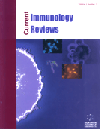- Home
- A-Z Publications
- Current Immunology Reviews (Discontinued)
- Previous Issues
- Volume 14, Issue 2, 2018
Current Immunology Reviews (Discontinued) - Volume 14, Issue 2, 2018
Volume 14, Issue 2, 2018
-
-
Osteoarthritis: Potential for Herbal Medicines as Therapies in the Management of Chronic Inflammatory Damage
More LessAuthors: Diana R. Cundell and Kathryn E. MickleOsteoarthritis results from a chronic inflammation-mediated destruction of synovial joints particularly in the hand, hip, and knee. Intervention strategies primarily focus on reducing this inflammation and its associated pain and involve a hierarchy of pharmaceuticals designed to prolong activity and prevent early joint replacement. Unfortunately, side effects from these agents are significant and their efficacy, especially in Read More
-
-
-
Cytokine Gene Polymorphisms in Cancer and Inflammatory Disorders
More LessAuthors: Hanim K. Norhalifah, Nor F. C. Mat and Hisham Atan EdinurGenetics has become increasingly important in disease prevention, diagnosis and treatments. Currently, molecular sequencing within medically important genes such as those coded for human leukocyte antigens, blood group and killer cell immunoglobulin-like receptors has been elucidated and their sequence variations have been deposited in public databases (e.g. allelefrequencies.net database). In addition, medical geneti Read More
-
-
-
Immune Checkpoint Inhibitor Therapy and Risk of Myocarditis: A Review of the Literature
More LessAuthors: Matthew Kelling, Michelle Dimza and Samir DaliaThe emergence of immunotherapies in the field of oncology has improved outcomes and given hope to patients with cancer diagnoses that have traditionally carried a poor prognosis. Specifically, Immune Checkpoint Inhibitors (ICIs), target Cytotoxic T Lymphocyte-Associated Antigen 4 (CTLA-4) and Programmed Cell Death 1 (PD-1), all of which have key roles in regulating the immune response. Manipulation of these immune c Read More
-
-
-
Natural Killer Cells: Prospects in Cancer Immunotherapy
More LessIn cancer immunotherapy, Natural Killer (NK) cells have achieved prominence. NK cells were identified in the 1970s as a subgroup of lymphocytes containing larger cytoplasmic granules. These cells are widely distributed in all lymphoid and non-lymphoid tissues, including bone marrow, lymph nodes, the spleen, peripheral blood, the lungs and liver. Because they do not present gene rearrangements during their ontogeny, they Read More
-
-
-
Clinical Approach to Systemic Autoinflammatory Disorders: Classification, Disease Phenotypes and Management
More LessBy Tiago BorgesAutoinflammatory Disorders (AIDs) can be either systemic or organ-specific. Systemic AIDs are associated with a primary dysfunction of the innate immunity that results in clinical signs of inflammation and/or elevated serum levels of acute-phase reactants. AIDs often present with rash, serositis, arthritis and/or aphthosis. Hereditary periodic fever syndromes, such as Familial Mediterranean Fever (FMF) and Tumor Necrosi Read More
-
-
-
Lambert-Eaton Myasthenic Syndrome: A Very Rare and Tortuously Exasperating Facet of Pre-Synaptic Disorder of Neuromuscular Junction
More LessAuthors: Aryendu K. Saini, Suresh Chandra and Awani Kumar RaiLambert-Eaton Myasthenic Syndrome (LEMS) is a very rare and unusual autoimmune disorder of Neuromuscular Junction (NMJ) that is associated with impaired neuromuscular transmission due to loss of voltage-gated calcium channel (VGCC) present on the pre-synaptic nerve terminal. Of all the different proteins like synaptotagmin that are attacked by auto-antibodies, P/Q-type of VGCC is found to be targeted in 90 % of patie Read More
-
-
-
Computational Analysis of Specific IgE Epitopes Responsible for Allergy to Fish
More LessAuthors: Mohsen Mohammadi, Reza Falak, Reza Z. Emameh, Soheila June Maleki and Gholam Ali KardarBackground: Fish is one of the most common causes of IgE-mediated adverse reactions to food. Several allergens have been identified and characterized from different fish species, among them, parvalbumin, as a highly conserved protein, is the most common causative agent of fish-borne allergies. Although most fish-allergic patients are sensitive to various species, some patients only show hypersensitivity to certain Read More
-
Most Read This Month
Article
content/journals/cir
Journal
10
5
false
en


